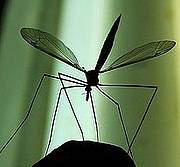Health warning: climate change will hurt
24 September 2008 | News story
Global warming as a result of climate change is changing the patterns and distribution of disease.
Carried by freshwater snails, schistosomiasis, or acute snail fever, is a fatal parasitic disease that attacks humans’ blood and liver. The schistosomiasis-carrying bacteria in the snail are surviving further north because of warmer water temperatures in winter.
“We are seeing higher exposure to the disease due to the moving north of the freezing line,” said Roberto Bertollini, World Health Organisation (WHO) coordinator for evidence and policy on environmental health.
The Nobel Peace Prize winning Intergovernmental Panel on Climate Change (IPCC) has warned that one of the consequences of climate change will be alterations in the frequency and distribution of infectious diseases around the globe.
But the implications of climate change for human health extend well beyond infectious diseases.
From the frozen arctic to steamy tropical zones, weather conditions have a powerful direct and indirect impact on human life.
Extreme weather events such as storms and heat waves, droughts and floods, which climate change models suggest will become more frequent, have a direct and often devastating effect on human health. Climate change can also have a huge indirect effect through its impact on water and air quality, for example, and food supplies.
The World Health Organization (WHO) estimates that climate change may already be causing over 150,000 deaths per year from increased disasters and changing disease patterns, and these risks are expected to intensify.
“Climate change hurts, it is a powerful threat to health,” says Bertollini.
NOT SURPRISING
This should come as no great surprise. Human history testifies to a strong connection between seasons, weather patterns and disease.
In more recent times, a clear correlation has been shown between the El Nino weather phenomenon and outbreaks of malaria, cholera and respiratory diseases in various parts of the globe.
El Nino, which results from a warming of the eastern Pacific off Ecuador and Peru, leads to abnormally heavy rains in South America and Africa, milder winters in the northern hemisphere and droughts in South East Asia and Australia.
The people most vulnerable to the health impacts of climate change are likely to be those already most exposed to environmental health threats because of poor water supply, sanitation and housing. Floods in Bangladesh, for example, always bring with them the risk of cholera outbreaks.
“Any time that you have a flooding in situations that are very fragile, like in Bangladesh and other countries, then the diseases linked to water increase dramatically,” says Bertollini.
But it is not just an excess of rain that poses problems. More variable rainfall patterns – another predicted consequence of climate change -- are likely to make fresh water scarcer in parts of the world. In Africa, most people do not have reasonable access to safe drinking water or adequate sanitation.
Unsafe water increases the risk of diarrhoea, which already kills approximately 1.8 million people every year.
“There are different kinds of health impacts. Droughts have an impact on natural resources and food security, so we may see malnutrition and above all, increasing poverty. The resilience of poor populations is becoming weaker and increasing their vulnerability due to the climate change phenomenon,” says Ninni Ikkala, climate change officer at the International Union for Conservation of Nature (IUCN).
“It may be difficult to say that climate change caused increased incidence of diarrhoea or malaria in a particular region, but it is definitely an increased stress factor for people that are already vulnerable and experiencing health problems,” Ikkala notes.
NOT JUST THE POOR
Although they may be the most vulnerable, poor countries are not the only ones threatened by climate change.
The WHO estimates that record high temperatures in western Europe in the summer of 2003 probably caused some 70 000 more deaths, mostly amongst the elderly, than equivalent periods in previous years. France was particularly hard hit.
Increasing global temperatures affect levels and seasonal patterns of both man-made and natural air-borne particles, such as plant pollen, which can trigger asthma.
About 300 million people suffer from asthma, and 255 000 people died of the disease in 2005. Health officials fear that asthma deaths could rise by almost 20 percent in the next 10 years as a result of global warming.
In July last year, northern Italy suffered an outbreak of a tropical, mosquito-borne disease called chikungunuya, which had previously been unknown in Western Europe.
The sickness, which causes severe back pains and fever, but does not kill, is transmitted by tiger mosquitos – a very aggressive mosquito that lives in small pools of water.
“For the first time we had a tropical disease in Europe. Climate change could make these episodes more frequent and more serious,” says the WHO’s Bertollini.
In many parts of southern Europe -- southern France, Italy, Spain and Greece -- malaria-carrying mosquitos can easily live and, in fact, were living until the middle of the 20th century.
But Europe is protected by strict environmental monitoring and strong public health systems. As in the case of chikungunya, public health systems can intervene and halt the problem, Bertollini says. Health infrastructures in many developing countries, however, are already stretched beyond their capacity to supply even basic health protection.
“Of course, if you have a public health system that is weak, then the population is more vulnerable,” he says.
HEALTHY ENVIRONMENTS, HEALTHY PEOPLE
While there is an increasing awareness that climate change poses significant health threats, WHO officials say insufficient attention is being paid to defining exactly what vulnerable and resource-poor developing countries can do differently.
The United Nations health organisation plans a special pilot project to study seven developing countries which exemplify some of the major challenges climate change poses to health.
Two are upland areas -- Bhutan and Kenya: two are water-stressed -- Jordan and Uzbekistan; and two are low-lying developing areas --Barbados and Fiji. The seventh is China, which encompasses a broad range of health vulnerabilities.
Stronger environmental policies, along with improved public health services, are clearly part of the needed response.
The World Conservation Congress, the four-yearly conference of the IUCN, being held in Barcelona, Spain, Oct 5-14, will be highlighting the relationship between the environment and human health.
The meeting of the IUCN, the world’s largest and oldest international environmental organisation, will bring together over 8,000 scientists, environmentalists, members of government and non-governmental organisations in search of “ideas, action and solutions for a diverse and sustainable world.”
“If we manage natural resources sustainably and put in place conservation measures, for example in preparing for extreme weather events, this can provide solutions to diminishing the impact of climate change on health,” says Ikkala.
Opinions expressed in this article do not necessarily reflect the views of IUCN, its Council or its members.






